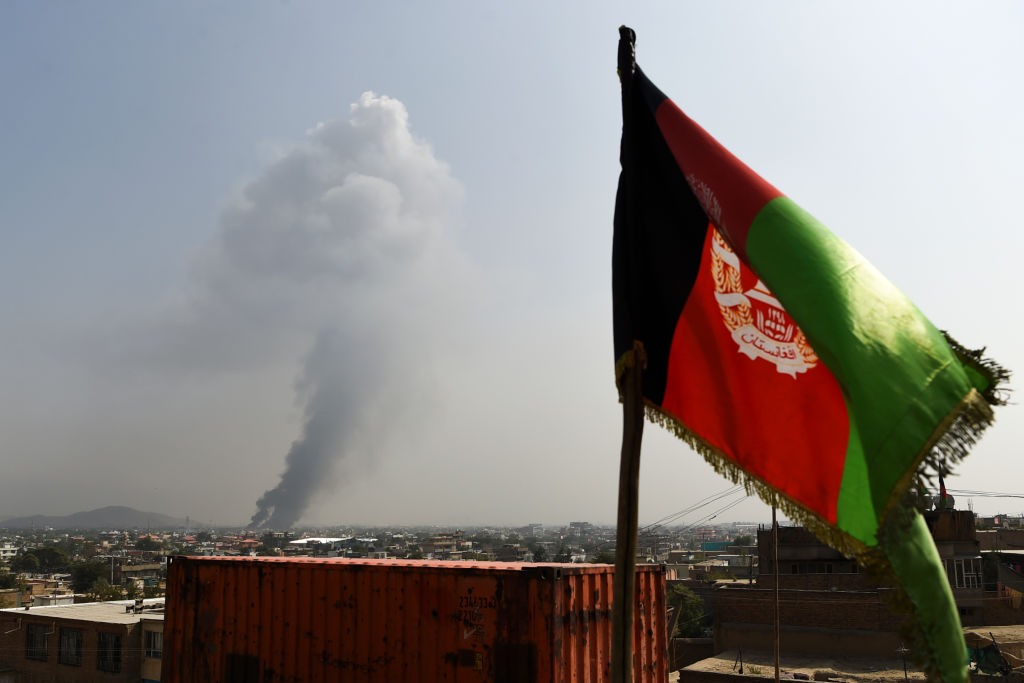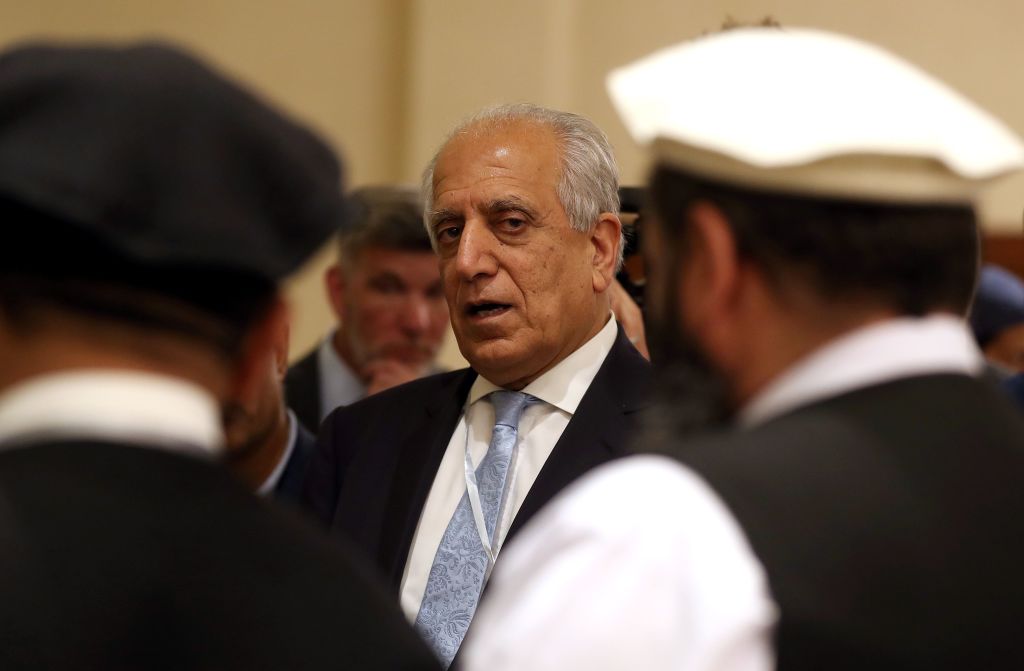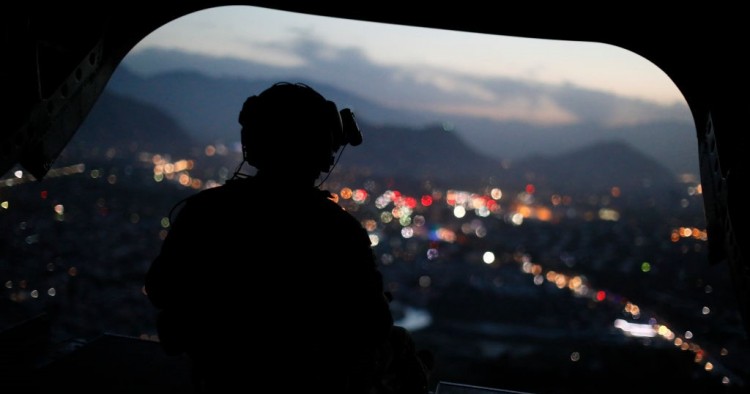18 years after CIA and U.S. special operations elements touched down in Afghanistan to pursue al-Qaeda and topple the Taliban, ongoing, incremental troop reductions reveal the smoke and mirrors manner in which the U.S. is withdrawing from the conflict in lieu of a negotiated settlement. Persistent Taliban attacks against civilian targets demonstrate its focus on U.S. actions, as opposed to the president’s tough talk. Opinions are more divided than the war-torn country itself, yet the increasing media tempo suggests another prospective American agreement with the Taliban is forthcoming. Regardless, U.S. actions make clear the inevitable, absent a dramatic and unlikely change. How we choose to pick up the broken pieces will determine our fortunes in meeting the ensuing resurgent terrorist threat.
The U.S. special representative for Afghanistan reconciliation, Ambassador Zalmay Khalilzad, regularly tweets about the steady progress of negotiations. His rosy outlook, however, is contradicted by the Taliban’s rejection of direct talks with the government and ongoing terror campaign aimed at intimidating and subduing their largely urban-based opposition. The ambassador’s encouraging updates are eerily similar to the upbeat tales a Dec. 9, 2019 New York Times report revealed had been spun by American officials over the years to conceal pessimistic assessments about the long-running military campaign. Such déjà vu should provoke reasonable doubt among Americans and give them reason to pause before accepting any agreement at face value. While there likely is no absolutely right solution for Afghanistan, there are several declinations of the least wrong.
As the CIA’s chief for counterterrorism in South Asia I learned that few operational theaters so demand attention to history as does Afghanistan and its neighbors. One would think Ambassador Khalilzad’s Afghan origins and previous service as America’s ambassador to Kabul would make him uniquely qualified to choose wisely from among paths otherwise littered with previous failures. Since muscling out Principal Deputy Assistant Secretary of State Ambassador Alice Wells by convincing President Donald Trump of his ability to succeed where others had failed, Khalilzad has chosen a road of appeasement. Concessions granted the Taliban and their Pakistani patrons have failed to draw gestures in kind. Wells, who held a tougher line with the various parties, was largely cut out of the strategy and coordination, and she is routinely excluded from Khalilzad’s meetings. His independent course has undermined her relationships and leverage among those from whom we seek compromises, particularly in Islamabad.
Still, against the backdrop of Ambassador Khalilzad’s rush to appease the Taliban and unreciprocated U.S. troop withdrawals, all is not necessarily lost. Maintaining our fingers in the dike, however, will come at a price, including choices that both the American left and right will find distasteful. For example, although the Soviet Union withdrew its remaining forces from Afghanistan in February 1989, the government it imposed under President Mohammad Najibullah endured until 1992. The fall came only after the Soviet Union’s collapse ended the funding used to rent the warlords’ loyalty. Afghanistan is no less divided today, with regional strongmen continuing to defy central authority and an even more prominent demographic shift to the cities. Moreover, the Taliban is hardly a monolithic organization. Tribalism, blood feuds, competition, and topography lend often to rather Darwinian outcomes.
Americans are justifiably exhausted after years of lost blood and treasure. Many understandably see the episode as having been a total waste. The reality is that America went to Afghanistan to prevent another 9/11, secure justice for the almost 3,000 who died, and topple the Taliban regime that had enabled al-Qaeda’s attacks. Arguably, we succeeded, and the contributions from U.S. and coalition service members, diplomats, intelligence officers, and aid and reconstruction workers in that regard were not in vain.
Our failure was in moving the goal posts for the end game and the inconsistent and oft incongruous vision in executing a wholly unsuitable American-imposed nation-building model. The ensuing cascade of errors in mismanaged and frequently contradictory policies solidified rather than reduced corruption and widened the country’s political, ethnic, and regional fractures. These policies in turn enabled the diversion of resources intended to empower democratic forces, strengthen the nation’s military, police, and intelligence capabilities, and provide the necessary infrastructure and opportunities for economic development.
Pain from these mistakes should not be neglected but must necessarily be accompanied by realistic expectations informing strategy and America’s ensuing security posture. Our conditions-based departure centers on securing the Taliban’s rather questionable commitment to prevent terrorist groups from mounting external attacks from Afghan soil and conduct direct negotiations with the Kabul-based central government. Let’s start with the reality that the Taliban will be hard pressed to live up to these minimal conditions, even if it wanted. And the U.S. knows it.

Taliban leaders are hardly household names in America but similarly lack unchallenged support at home. American forces are already withdrawing unconditionally. International Security Assistance Force contributors among coalition partners will certainly follow suit. Politically, the recent Afghan elections produced an embarrassingly low turnout and dubious results, undermining any semblance of unity among Western-leaning, democratic forces. Taliban leaders thus have little incentive to sell concessions to a rank and file who see victory as inevitable and believe themselves operating from a position of strength.
Each unreciprocated American gesture reflects weakness that further emboldens the Taliban, a reality the British learned the hard way during the first Anglo-Afghan War in 1842, when, despite treaties guaranteeing safe passage, their exit from Kabul turned into a death march and eventual massacre. Moreover, by excluding the Afghan government from talks and pressuring it to accept unilateral U.S. decisions, America validated the Taliban’s depiction of the regime of President Ashraf Ghani as an illegitimate puppet.
Another major consideration is Pashtunwali, a code of conduct that predates Islam. The tenet of Nanawatai, or sanctuary, requires the Pashtun to provide protection to those on the run from enemies, even the law. Like Melmastia, the principle of showing hospitality, these customs make it rather unlikely the Taliban would follow through with any commitments concerning al-Qaeda. The willingness of Afghans and Pakistanis who have served al-Qaeda to endure hardship, detention, and death for their guests defies Western understanding.
Further, Pashtun standards for Nyaw aw Badal, or justice and revenge, set no time limits until honor can be satisfied for the many who have scores to settle. Despite Taliban messaging that Pashtunwali will not impede negotiations, I’d be wary. And do Taliban allies such as al-Qaeda, Tehreek-e-Taliban Pakistan (TTP), or Lashkar-e-Taiba (LeT) have a vote? If they oppose, how will the Taliban overcome the vast ungoverned and mountainous territory that enabled its own struggle?
Just who is even speaking for the Taliban? Former Taliban Defense Minister and Mullah Omar’s one-time deputy Mullah Abdul Ghani Baradar, ostensibly the senior representative, was allowed to waste away in a Pakistani prison for eight years given his fall from grace. His release came not at the Taliban’s request, but Ambassador Khalilzad’s. Meanwhile, Taliban leader Mullah Haibatullah Akhundzada has remained publicly silent. Akhundzada’s own degree of control likewise can’t be assumed. He holds the leadership by virtue of his religious credentials and southern Afghanistan connections, not his personal military achievements. He is a scholar and consensus builder unlikely to take personal risks.
Mohammad Yaqoob is Mullah Omar’s eldest son. Still in his late 20s, Yaqoob lacks battlefield experience, and his bloodline provides little guarantee of his father’s loyal following. Yaqoob claims support through his appeal to younger, up-and-coming field commanders, who grew up not in the era of Taliban rule, but during the exhausting years of struggle that followed. However, he spends rather little, if any, time actually in Afghanistan to nurture such relationships. Still, Kabul’s Government of National Unity and the U.S. had been gambling that Yaqoob is both influential and pliable.
The Taliban’s other deputy, Sirajuddin Haqqani, perhaps represents a more intriguing wildcard. The eldest living son of our deceased, one-time ally against the Soviets, Jalaluddin Haqqani, Sirajuddin leads the shadowy Haqqani Taliban Network (HQN). In practicality a vast criminal network, the HQN is technically part of the Taliban, but self-sufficient and distinct. Separated by mountain ranges from the southern Pasthun as well as Afghanistan’s northern Tajiks and Uzbeks, the Haqqani preside over a confederation of eastern Afghan tribes with extensive commercial and criminal interests that span into western Pakistan.
The HQN is ruthless, responsible for the overwhelming majority of suicide attacks in Afghanistan’s capital and eastern cities, as well as the improvised explosive device (IED) strikes against our service members. Still, loyalty to the greater Taliban is hardly written in stone, but currently aligns with family interests. The Haqqanis also have had more exposure to outsiders, and can be practical when the terms, or rather, the price is right. Dearest to them throughout the negotiations was the release from Afghan custody of Sirajuddin’s younger brother Anas, arrested in the Gulf on a fundraising trip some years back. And in the end, neither the Taliban nor the HQN incurred any costs beyond that which they had been willing to pay all along, releasing American hostage Kevin King and Australian captive Timothy Weeks — no cease-fire required. The Taliban and HQN never changed their terms, Khalilzad simply conceded, forcing Ghani to go along.

There are similarly other cracks on which the U.S. could focus. The U.S. has done poorly in exploiting grass-roots sentiments and concerns among the Taliban’s following, but it’s never too late. Taliban and HQN fighters are not the same ideologically driven foot soldiers of the 1990s. Most are in it for a paycheck. The ease with which they embraced the Ramadan cease-fire and mixed happily among their “enemies” scared their leaders and suggests the rank and file are ready for the conflict to end, if their interests can be assured. This has been the greatest impediment to a cease-fire inasmuch as Taliban and HQN leaders fear that once stood down, fighters might be less willing to return if negotiations fell through.
The Taliban, and to an even greater extent the HQN, depend on logistical and security support from Pakistan’s Interservices Intelligence (ISI). ISI’s assistance is critical in moving fighters, suicide bombers, and weapons across the border. Equally if not more important is ISI’s protection from America. ISI actively undermined Western efforts to target Taliban and HQN leaders enjoying safe haven in Pakistan’s settled areas as well as those to locate U.S. and Australian hostages.
For Pakistan, Afghanistan is merely a front in the Indian conflict, the existential threat which shapes its worldview. Pakistan’s predisposition toward the Taliban stems from justifiably perceived U.S. favoritism for India and suspicions over the Kabul government’s warm ties with New Delhi. Still, Pakistan’s relationship with the Taliban and HQN is a marriage of convenience, with no love lost among the parties. Most Afghans recognize Pakistan’s duplicitous nature and abhor its meddling.
Achieving America’s security objectives requires a minimum set of enforceable commitments. An ongoing, limited, U.S. military special operations and intelligence presence therefore remains necessary. Such infrastructure enables intelligence collection, provides capabilities with which to preempt terrorist threats, and stands as a visible deterrent capable of imposing a cost should the Taliban fail to abide by its commitments. Such a small footprint would be tenuous, but sustainable.
The U.S. must also continue to fund not only the central government, but likewise regional and tribal figures who can preserve stability under their control. If whomever is ultimately left standing as Afghanistan’s president can legitimately enlist partners from among the country’s disparate regional and ethnic leaders, so much the better. Regardless, the U.S. should cultivate its own arrangements through financial and material largesse. Now is not the time to pretend about whom with which we wish to partner on the ground.
Along the same lines, the U.S. should be more aggressive in striking deals among the Taliban’s competing factions. As painful as it would be to do so, there is no better target than the HQN. Similarly, even among the southern and southwestern Pashtun and other ethnic communities are groups with which the U.S. can broker separate peace arrangements. The right incentives could be too hard to pass up if accompanied by accommodations for regional autonomy like that practiced by the Kurds in northern Iraq. Kabul’s central government need only play by the agreed upon political power sharing rules hammered out in 2014 if outraged over our intrusion into its sovereignty.
The local ISIS affiliate, Islamic State Khorasan Province (ISKP), still looms as a persistent worry for all stakeholders, Pakistan included. ISIS threatens the Taliban and HQN on the battlefield, and likewise draws from their sources of men, money, and material. With many of ISKP’s most hardcore members in fact TTP defectors, even Islamabad can’t afford to dismiss U.S. assistance. Neither the Taliban nor the HQN are in any position to guarantee that ISIS won’t attack the West or Pakistan from Afghanistan when they can’t even protect themselves from this group. Perhaps the fig leaf under which the Taliban, HQN, and Pakistan can politically accommodate some degree of enduring U.S. presence would be if it were ascribed toward cooperation against ISKP. For Pakistan, an added incentive would be continued U.S. TTP targeting.
As always in Afghanistan, equilibrium will eventually come, but with time and sadly more violence. The future reality will likely reflect the past, such as the resurgence of regional warlords. Such has been the cycle, one unlikely to change until Afghans themselves overwhelming decide differently. In the meantime, our negotiators need at minimum to offer the Taliban, HQN, and Pakistan an incentive-laden, face-saving means for the U.S. to continue suppressing the threat from al-Qaeda and its partner organizations. And we also need to complement that carrot with a stick with which the U.S. can remain an existential threat to their collective authority, finances, and control. We must otherwise accept the coming withdrawal with realistic expectations. Absent the application of continuous pressure on those operating within the sanctuary of ungoverned Afghanistan space, we can expect our terrorist foes to again look outward, and toward the West.
Douglas London is a retired CIA Clandestine Service senior operations officer and an adjunct associate professor at Georgetown University’s Center for Security Studies. His assignments spanned the Middle East, South Asia, Africa, and Central Eurasia, during which time he served several times as a CIA chief of station. Mr. London retired at the end of 2018, and his last assignment was as the CIA’s chief of counterterrorism for South and Southwest Asia. You can follow him on Twitter @douglaslondon5. The views expressed in this article are his own.
Photo by JONATHAN ERNST/AFP via Getty Images
The Middle East Institute (MEI) is an independent, non-partisan, non-for-profit, educational organization. It does not engage in advocacy and its scholars’ opinions are their own. MEI welcomes financial donations, but retains sole editorial control over its work and its publications reflect only the authors’ views. For a listing of MEI donors, please click here.












